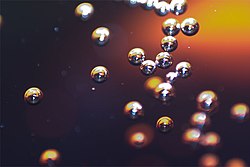This article needs additional citations for verification .(November 2021) |

Effervescence is the escape of gas from an aqueous solution and the foaming or fizzing that results from that release. [1] The word effervescence is derived from the Latin verb fervere (to boil), preceded by the adverb ex. It has the same linguistic root as the word fermentation.[ citation needed ]
Contents
Effervescence can also be observed when opening a bottle of champagne, beer or carbonated soft drink. The visible bubbles are produced by the escape from solution of the dissolved gas (which itself is not visible while dissolved in the liquid).